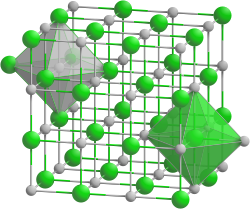 | |
| Names | |
|---|---|
| Other names Scandium monophosphide, [1] phosphanylidynescandium | |
| Identifiers | |
3D model (JSmol) | |
| ChemSpider | |
| ECHA InfoCard | 100.032.153 |
| EC Number |
|
PubChem CID | |
| |
| |
| Properties | |
| ScP | |
| Molar mass | 75.929670 g·mol−1 |
| Structure [2] | |
| Rock salt structure | |
| Fm3m | |
a = 0.5312 nm | |
Formula units (Z) | 4 |
| Octahedral at Sc3+, Octahedral at P3- | |
| Related compounds | |
Other anions | |
Other cations | |
Except where otherwise noted, data are given for materials in their standard state (at 25 °C [77 °F], 100 kPa). | |
Scandium phosphide is an inorganic compound of scandium and phosphorus with the chemical formula Sc P . [3] [4] [5]